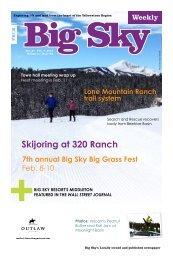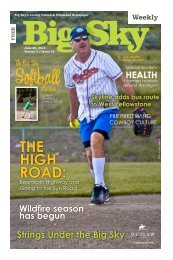health + wellness - Explore Big Sky
health + wellness - Explore Big Sky
health + wellness - Explore Big Sky
Create successful ePaper yourself
Turn your PDF publications into a flip-book with our unique Google optimized e-Paper software.
cornfields to Mountains<br />
altitude awareness<br />
by derek Meyer<br />
I’m from a cornfield south of Chicago<br />
– about 600 feet above sea level. Like<br />
many of our patients, I felt the altitude<br />
at <strong>Big</strong> <strong>Sky</strong> my first week. Altitude related<br />
illnesses were very rarely discussed<br />
in my Midwestern medical education.<br />
But it’s different<br />
story<br />
at 6,000<br />
feet above<br />
sea level,<br />
where<br />
altitude can<br />
wreak havoc on unsuspecting tourists.<br />
In late June, a patient on a road trip<br />
from a California coastal city came to<br />
the clinic complaining he couldn’t catch<br />
his breath. He said this started a few<br />
days earlier and at lower altitude. He’d<br />
been on a strenuous hike in Yellowstone<br />
when he began to feel nauseated,<br />
dizzy and short of breath. At a local<br />
hospital, the patient’s blood oxygen<br />
level was found to be severely low.<br />
After close observation, with oxygen<br />
provided, the patient recovered and was<br />
discharged.<br />
Unfortunately, his travel plans for the<br />
next day sent him 2,000 feet higher,<br />
to <strong>Big</strong> <strong>Sky</strong>. In the clinic here, his blood<br />
oxygen was again low, and he was<br />
huffing and puffing up a storm. We<br />
provided oxygen, ran a few tests, and<br />
recommended he either take an oxygen<br />
machine back to the condo and rest, or<br />
altitude sickness commonly occurs in<br />
people ascending more than 8,200<br />
feet and is a result of the body’s<br />
faulty response to low blood oxygen.<br />
descend to<br />
Bozeman –<br />
wisely, he<br />
chose the<br />
latter.<br />
Altitude<br />
sickness commonly occurs in people<br />
ascending more than 8,200 feet and is<br />
a result of the body’s faulty response<br />
to low blood oxygen. The three main<br />
altitude sickness syndromes include:<br />
· Acute mountain sickness (AMS)<br />
· High-altitude cerebral edema<br />
(HACE)<br />
· High-altitude pulmonary edema<br />
(HAPE)<br />
In most cases, a mild form of AMS<br />
occurs 6-12 hours after reaching high<br />
altitude, and one may experience headache,<br />
nausea or vomiting. Fortunately,<br />
AMS will usually resolve by stopping<br />
INTERIOR PAINTING<br />
We bring quality and<br />
value to the simplest<br />
jobs as well as some of<br />
the most demanding<br />
projects.<br />
There are a lot of important details involved<br />
in painting and finishing a home, and we love<br />
sweating the details!<br />
further ascent and taking an ibuprofen<br />
for the headache.<br />
HACE and HAPE are much more<br />
severe and can lead to coma and death<br />
if left untreated. In HACE (which<br />
typically follows AMS), the brain<br />
begins to swell, leading to changes in<br />
a person’s level of consciousness. In<br />
HAPE (which may occur after two to<br />
four days at altitude), the lungs become<br />
leaky, causing coughing and shortness<br />
of breath. For both of these conditions,<br />
immediate descent with oxygen and<br />
drug therapy is lifesaving. Luckily, Dr.<br />
Daniels only sees a case of HAPE about<br />
every two years around here.<br />
Mountain Village - 995-2797<br />
Located next to <strong>Big</strong> <strong>Sky</strong> Ski Patrol<br />
explorebigsky.com<br />
So what advice can you give your<br />
visiting cousin from Miami who has<br />
ambitions to hike the Spanish Peaks<br />
this summer? Tell him to take it easy!<br />
The best strategy for avoiding altitude<br />
sickness is gradual ascent with plenty<br />
of rest. For someone with a history<br />
of mild AMS, a physician may recommend<br />
taking a medication called<br />
Diamox. Avoiding alcohol isn’t a bad<br />
idea, either.<br />
Derek Meyer is a forth year medical<br />
student at the University of Illinois College<br />
of Medicine. He did a rotation at the<br />
Medical Clinic of <strong>Big</strong> <strong>Sky</strong> in 2011.<br />
Medical clinic Of <strong>Big</strong> <strong>Sky</strong><br />
Physicians available after hours for emergencies<br />
The Mountain Village Clinic is open 7days a week throughout ski season 10am - 5pm<br />
Meadow town center - 993-2797<br />
Located at the corner of Ousel Falls Rd. & Hwy. 64<br />
The Meadow Village Clinic is open Mondays ONLY 10:00am - 5:00pm<br />
Jeffery a. daniels M.d.<br />
Expertise in Internal Medicine, Sports Medicine, Family Care<br />
& Well Woman Health Care<br />
**X-Ray machine on the premises**<br />
We are well equipped to handle your medical problems promptly<br />
No appoinments necessary, walk-ins always welcome<br />
Blue Cross/Blue Shield, Medicare, & Workers Compensation Insurance, Cash, Checks, Credit Cards accepted - Payment due at time of service<br />
EXTERIOR PAINTING<br />
We excel at exterior<br />
painting, staining, and<br />
log home renovation.<br />
406-580-0331 | email: cboyd@montanapaintinc.com<br />
Check out www.montanapaintinc.com for all the juicy details!<br />
10+<br />
YEARS OF LOCAL EXPERTISE<br />
July 15, 2011 35

















